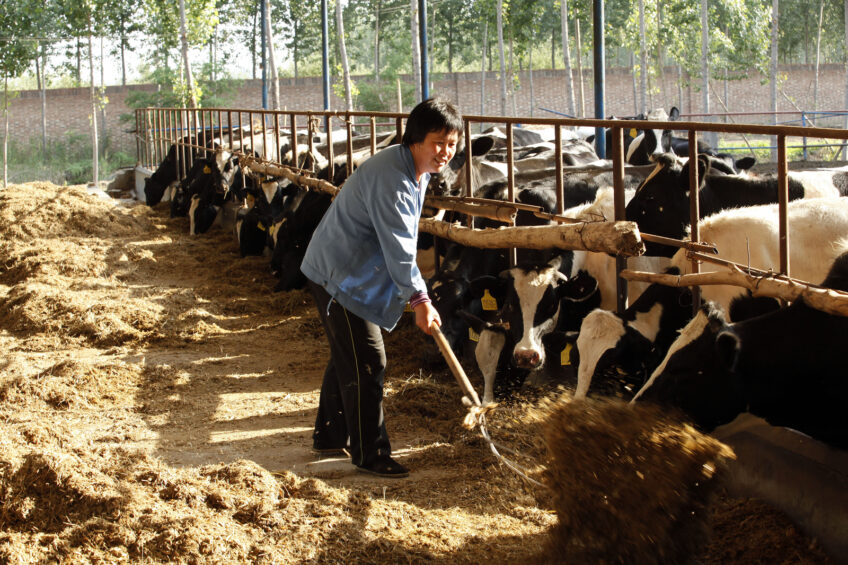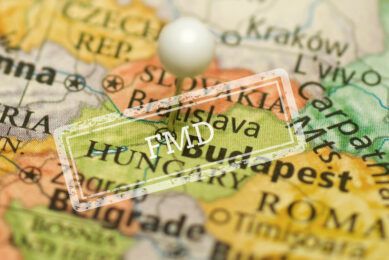From zero to hero

China is a good example of how fast an industry can change and turn the dairy world upside down. This article will explain the dynamics behind this revolution and takes a brief look at what’s next – new challenges lie ahead for China’s dairy producers. As some of the key characteristics are typical for China, many lessons can be learnt to predict and steer the development of scaling dairy farming across Asia.
The role of Asia in dairy output is growing at an amazing rate, right now almost all is pushed by China as well as India and Pakistan. While most regions of the world show growth in dairy output, the production growth in Asia is fuelled by increasing demand for fresh milk products. The dairy processing businesses are maturing to meet the demands, and diverting from imports to build and promote their domestic supply lines. The vast size of the country and population; the diverse climatic regions providing the basics for many different agricultural practices; the fast economic development enabling purchase power abroad, adapting new technologies and above all income growth and therefore changing consumer preferences – they are all significant factors. But arguably the most outstanding incentive for the development of China as a dairy powerhouse is the empowered vision of its leaders. It can be summarised by a speech of former premier Wen Jiabao in 2006: “I have a dream. And my dream is that each Chinese person, especially children, can afford to buy one jin (500 grams) of milk to drink every day.” With this dream, Jiabao gave the Chinese dairy business the ultimate mandate.
We don’t have to dive deep in China’s history to explain the dairy development. China had no habits of drinking milk, so farmers used their cattle for many centuries to plough and pull carts. After the First Opium War in 1842, the Qing dynasty was forced to open up five coastal cities for foreign business. To get milk themselves, foreigners living in these cities – Guangzhou, Xiamen, Fuzhou, Ningbo and Shanghai – introduced dairy cows from Europe. It was the starting point of milk production in China. For the next 130 years, dairy production was concentrated in and around large cities like Beijing and Nanjing, delivering fresh products in the vicinity of consumers.

The opening-up and reform in 1978 is the first big turn-around, the introduction of ultra-high temperature (UHT) techniques the second. Rapid economic growth provided consumers with purchasing power, and demand for dairy products increased rapidly in the cities. Because of the urban expansion, the areas and opportunities to engage in dairy production were hampered – feeding capacity, feed supply, labour costs and environmental conditions. The milk output for Shanghai, Nanjing and Hangzhou fell accordingly between 1980 and 2010, while a considerable growth was still recorded around Beijing and Tianjin. However this increase could not catch up with the rising demand from fast growing cities.

In 1980, the coastal region (see the definitions of regions according to Dinghuan Hu, Fan Ruiying, Lin Ting and Liu Bing, on the map below) where all these cities are situated, accounted for 33.6% of the Chinese population, and the output of dairy was 34.2% of the total. Three decades later, 37.5% of all citizens live in the region while the share of dairy output went down to 14.3%. These cities have to now rely on other regions for their dairy demand. The much more spacious ‘middle region’ (see map below) is dominated by arable farming. There is dairy farming as well, in 1980 the region accounted for 32.4% of the country’s total dairy output. The amount is still the same as in 2010. The northwest region, the third region, is characterised by a vast territory, rich in feed resources (grassland area), suitable climate for dairy farming, and pastoral tradition. The population density is low, only 12% of people live there. The dairy output grew from 43.3% of the total in 1980 to 53.1% in 2010. Those conditions are not enough to explain the rapid development, even taking into consideration the abolition of planned purchase and marketing by the state, and permitting the circulation of dairy products. However traditional pasteurised milk could not be preserved long enough for a long distance transportation to the urban consumers, which remained a blockade. The invention of UHT milk in 1961 solved the problem partially, but it took some 30 years to establish the supply chain to the large-populated cities. Some dairy companies, such as Bright and Yili, entered the market at the time.

In the 80s and 90s, UHT milk was imported as high-end consumer goods. Shanghai Bright Dairy Products Company introduced equipment to produce UHT milk in the mid 90s. However the production costs of raw milk around Shanghai were very high, so it wasn’t a success. Then Yili, a very small processing company in Inner Mongolia, introduced production lines and packaging material from abroad. Yili had the advantages of sufficient milk supply in its surroundings, and was successful in delivering UHT milk to the coastal region. It brought a significant change: in 2000, UHT milk output was 14.2% of the total output of liquid milk, just two years later it surpassed the proportion of pasteurised milk and in 2010 three out of four milk drinking people in China drank UHT milk. With this expansion, the demand for raw milk exploded and farmers in especially the western region began to convert to dairy farming, if they weren’t already doing that before but on a smaller scale. The economic benefits of feeding dairy cattle were and are much higher than other agricultural products. The figures below say a lot: the Chinese dairy herd size has grown from less than 3 million to 14.4 million, amongst 6.8 million milking cows, in just over 20 years. In 1957, it was only 160,000, it is not just numbers, significant importation of breeding stocks have improved the gene pool. Combined with improved management and nutrition and better quality of feeds and forage, milk yields made a steady growth since 2000.
Over the past decade, China has become the world’s third largest milk producer, and the predicted milk output will keep growing steadily at a pace of 5-7% a year in the years to come. The growth was predominantly realised on an industrial scale; while the majority of milk is still produced in backyard farms. Yet we see a structural change of the industry, with the consolidation going on. Since 2008 the number of dairy farms with less than 200 cows is declining, while the number of large farms is increasing. For example, the number of farms with more than 1,000 dairy cows grew by a staggering 42% between 2008 and 2010. Key drivers for this development are yield gains and cost savings, and incentives from the major dairy processing companies. With regard to genetics, large scale farms are able to invest in more productive livestock. In 2012, China imported 128,000 dairy cattle, almost all for new or enlarged scale dairy farms. As for the sourcing origins, Australia leads with 43%, followed by New Zealand at 28% and Uruguay at 25%. These dynamics are mainly driven by the leading processing companies. In the coastal region, most of the enterprises with state-owned background have their own dairy farms.

Shanghai Bright Dairy is an example. It owns 21 farms, with more than 20,000 cows and with an annual production of 96,000 tonnes of raw milk. Bright also acts as a co-operative for more than 500 large dairy farms. In 2008, the year of the melamine scandal, it stopped purchasing raw milk from small-scaled farmers and relied on its own group co-operative farmers since then. Another example is Yili, situated in the West with many small family dairy farms. These farmers don’t have the capital to buy dairy cattle, so the processing companies provide loans in return for raw milk the farmers produce. Yili adopts this model in Heilongjiang, Inner Mongolia and Hebei regions and has more than 5 million farmers transformed into raw milk producers and suppliers to Yili. The feed supply follows the growth of dairy farming. In 2011, nearly 70% of the dairy feed volume of 7.8 million tonnes is compound feed. The proportion of concentrate is 27%, premix feed accounts for 4% of total tonnage. Almost all large scale dairy farms use Total Mixed Ration (TMR) feeding to optimise production and get the best out of a variety of raw materials.

According to James Charteris-Hough of ABCA among others, there’s still progress to be made in optimising the diet. In order to get fibres, China imports a lot of alfalfa, oat hay and other fibre sources, especially from the US, to use on larger farms. While the imports are surging, initiatives are being taken to improve the domestic alfalfa supply. Next to growing in quantity all over the country, the key issues for the Chinese dairy farmers will be improving their production efficiency, plus the quality and safety of their products. Adapting the latest feeding technologies will be important to keep up with increasing demand for milk, which will continue to outpace domestic supply in the next decade. The dairy industry becomes a clear investment opportunity in China. No wonder the world’s largest food company, Nestlé, is investing almost US$400 million into the Dairy Farming Institute, a world class dairy training centre in Shuangcheng (Heilongjiang). Nestlé aims in this way to become China’s reference for dairy farming management.
 |  |
The biggest challenges today facing the Chinese dairy industry, recently summarised by vice-president Mark Lyons of Alltech, are the costs of production, fertility, rumen health, lameness and mycotoxins in feed or forage. He urged Chinese farmers to adapt to new technologies to the use of alternative feed ingredients and mycotoxin management to increase animal performance and profitability, while reducing the cost of feed. There’s no need to explain why: by 2030, 70% of all the people in China are expected to live in cities and milk consumption in China’s urban areas will be 4.5 times higher than in rural areas (15.4kg versus 3.5kg). With the increasing urban population and the rapidly growing middle class, milk consumption will rise by more than 50% compared to today. Chinese dairy farmers will need to significantly increase their production. The future is theirs.
This article was created in co-operation with Dinghuan Hu, Fan Ruiying, Lin Ting and Liu Bing (Wageningen UR China Office and Shengyang Agricultural University), authors of “Exploring the causes of rapid development of China’s Dairy industry”
Big players The total dairy sales market were almost US$50 billion in 2011. The top three Chinese dairy companies accounted for more than 35%: Mengniu, Yili and Bright Dairy. The first two are now included in the top 20 dairy companies worldwide, with Mengniu ranking in at 17th and Yili 19th. |
Join 13,000+ subscribers
Subscribe to our newsletter to stay updated about all the need-to-know content in the dairy sector, two times a week.










